By Suzanne A. Marshall from the December 2017 Edition
Part One
The dream came true. Here we are retired in a beautiful tropical paradise, smack on the beach in our small, but lovely, second floor condo. The port of Manzanillo is the busiest in Mexico now. We love to sit on our terrace and watch the ships come and go (sometimes a cruise ship). At night, those vessels that await unloading, anchor in the bay and are lit up like Christmas trees.
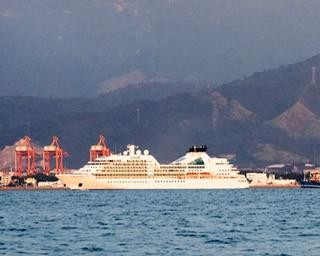
During the days, we can walk the beach, watch fishermen casting rods or nets and pelicans diving like darts straight into the sea. The sunsets are spectacular as our westward view has the sun setting on the horizon of the sea or behind the mountainous peninsula, depending on the time of year. Breathtaking.
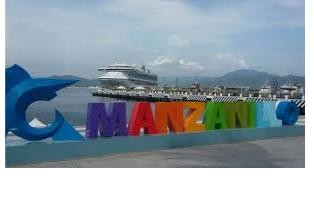
along with the hordes of container ships
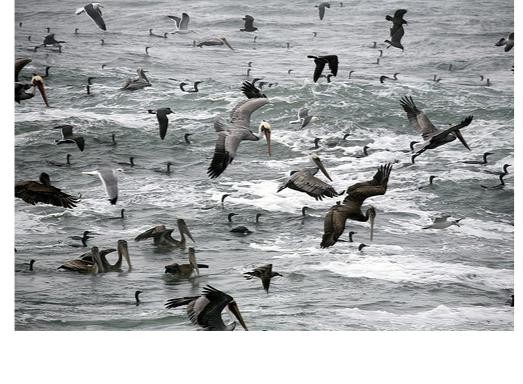
With the deep bay and open access to the Pacific Ocean, the surf that pounds the shores daily is magnificent to watch. When storms are out at sea, they send in such forceful waves that they actually ‘boom’ when they hit the shores. The waves liter-ally rearrange the beach into piles of sand and cliff-like structures. Windows rattle and you can feel the force of the vibrations under foot. At times one can also feel the mist of sea water carried in the air.
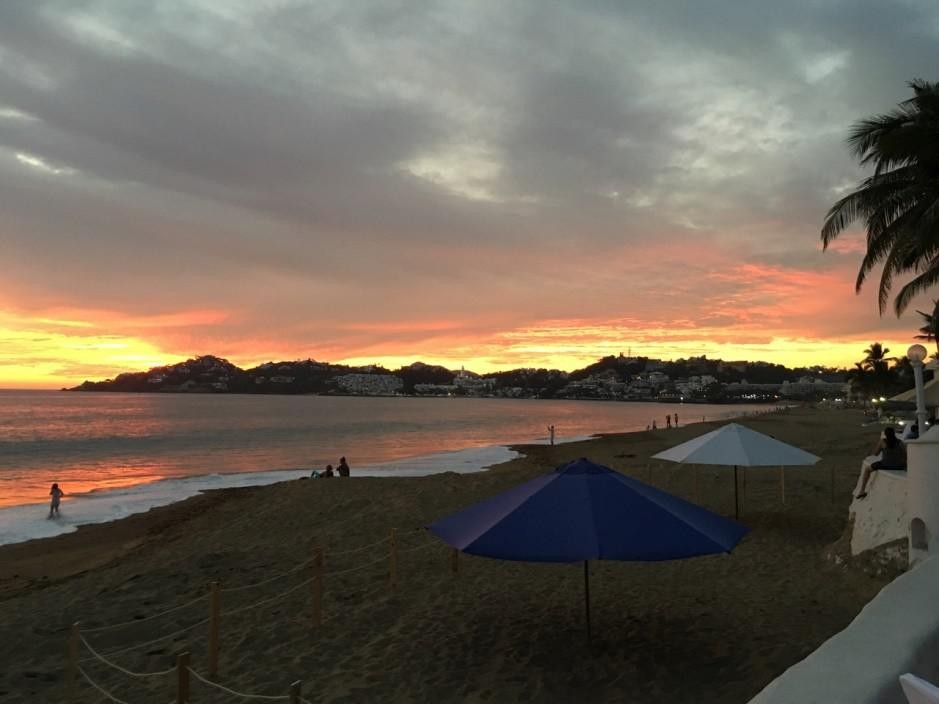
In December, the sunsets down our beach are stunning
behind the Punta, Las Hadas area
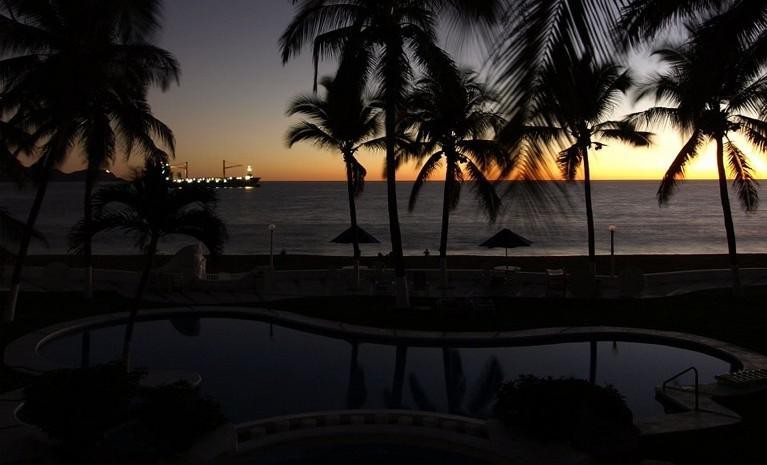
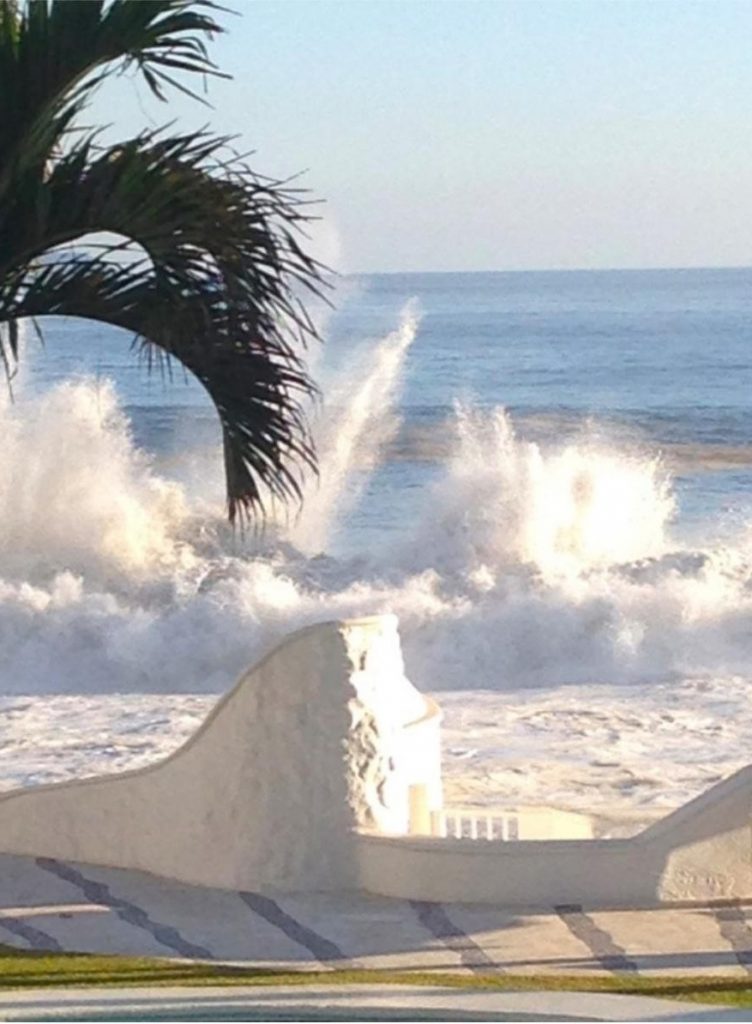
into the air right in front of the gate.
There are many benefits to seaside living. A person relaxes and decompresses from life’s stresses, blood pressure lowers, your skin clears and your nasal passages are bathed with moisture and salt air. If you’ve ever seen an aerial view of the earth at night from space, it demonstrates mans’ desire to be by water as the lights of cities cluster to the edges of the great continents. Presently, about 40% of the world’s population lives within 100 kilometers of the coast.
Initially, the purchase of our condo gave us the opportunity to make improvements and personalize our nest with fresh paint, new window coverings, pieces of art and upholstery, etc. When you are finally in retirement, this can be a lot of fun as op-posed to a ‘chore’. You’re not working anymore so you may as well enjoy the process. And so we did.With absolutely no comprehension of the corrosiveness of the sea air, we forged ahead making choices I would reconsider now.Window coverings and upholstery
If you are choosing curtain rods, you might want to consider wood headrails with perhaps wooden decorative finials. Try to avoid metal rods if at all possible. On the beach, metal rods are going to oxidize over time and rust. Some types of wooden headrails have an imbedded metal track behind them where curtain slides and hooks are placed. Some of these already existed in our condo and I rather liked the look of them. I had to do some sanding and smoothing on the imbedded metal tracks (wall side) so that the hook glides would move smoothly.Since then, I have learned to apply petroleum jelly to the track every now and then. I just rub it along the track with a rag. It also creates a barrier from the salt air. The small track glides that can be slid on at the open end of the curtains headrails can be purchased in plastic. Avoid the solid metal ones. The small hooks that are attached to the curtains are only found in metal by my experience, though plastic hooks do exist. There-fore, I am replacing them randomly as needed. I just keep a box of new ones in storage. Back in the dry climate of Canada, these metal products would last forever. Not so by the sea.
We wanted our two bedrooms well darkened for sleeping. When we took ownership of our unit, there were curtains with rubber backed linings and high-quality materials already hung by the previous owners. We decided to work with these in one of the rooms. This reusing worked well for our ‘pocket book’ and only now, ten years later, I am considering replacements. Astonishingly, the rubber backing on these high-quality curtains will also succumb to the sea air and the rubber is now crumbling and peeling off the material facing.
So the lesson learned is that the life cycle of even these well-made curtains is limited when you live on the beach. You will face replacement in future at some point. I estimate that these survived about twenty years! Not bad! I have completely given up on any ideas involving the latest home fashions as a creative outlet. Better to stick with high quality products and really make sure you like your original choices!
In the guest room, I had originally decided to cover the two windows with some lovely woven curtains brought from Canada. They looked great and worked beautifully with the ceramic tiled floors. But, they did not provide enough darkening at night so we opted for installation of some good quality, pull down blinds behind them which fitted nicely within the window frames.
We enjoyed these for one year and then on the next return trip for our winter stay, I walked into the guest room and could see that the salt air had faded the curtains by about 50%. The weave and the dyes were apparently no match for the seaside air. I can’t even blame the problem on sun bleach either since these windows do not receive direct light and the blinds were pulled down. Nope, it appears the culprit is definitely the salt air and humidity.
We wanted our two bedrooms well darkened for sleeping. When we took ownership of our unit, there were curtains with rubber backed linings and high-quality materials already hung by the previous owners. We decided to work with these in one of the rooms. This reusing worked well for our ‘pocket book’ and only now, ten years later, I am considering replacements. Astonishingly, the rubber backing on these high-quality curtains will also succumb to the sea air and the rubber is now crumbling and peeling off the material facing.
So the lesson learned is that the life cycle of even these well-made curtains is limited when you live on the beach. You will face replacement in future at some point. I estimate that these survived about twenty years! Not bad! I have completely given up on any ideas involving the latest home fashions as a creative outlet. Better to stick with high quality products and really make sure you like your original choices!
In the guest room, I had originally decided to cover the two windows with some lovely woven curtains brought from Canada. They looked great and worked beautifully with the ceramic tiled floors. But, they did not provide enough darkening at night so we opted for installation of some good quality, pull down blinds behind them which fitted nicely within the window frames.
We enjoyed these for one year and then on the next return trip for our winter stay, I walked into the guest room and could see that the salt air had faded the curtains by about 50%. The weave and the dyes were apparently no match for the seaside air. I can’t even blame the problem on sun bleach either since these windows do not receive direct light and the blinds were pulled down. Nope, it appears the culprit is definitely the salt air and humidity.
The blinds have become an issue now, too. It seems we left them rolled up too long. When we attempted to pull them down one day with the side chain (made of plastic) the PVC material of the blinds had stuck to itself and when we forced the blinds to open, large areas just peeled away as it unrolled. They had stuck together in the roll. I was mortified and struck again by the effects of humidity.
Now, when we close the blinds and curtains, you can see large blotches of light beaming through the damaged blinds and curtain materials. I am becoming a much wiser consumer now and hope I’m saving some of the readers from similar hassles. At this point, I’m assuming that the blinds perhaps need to be a different weave or material or at least raised and lowered regularly each day to avoid moisture collection. It’s hard to know until experience tells us.
I have also investigated venetian blinds, both horizontal and vertical. Some of them are quite lovely but unfortunately the headrails are made of steel or aluminum and we are faced with the same oxidation issues.
So now that I’ve shared that experience, you may be able to surmise what also happened to our newly upholstered living room seating cushions and the matching dining chairs and bar stools! Yup, the beautiful upholstery, complete with ‘scotch guarding’, was simply no match for the sea air and humidity. Within 3-4 years the fading was so bad we were shopping for materials again.
I would not normally endorse a brand name in an article but, since it happens to be the best solution to the problem, I’m going to recommend the indoor/outdoor materials brand called Sunbrella. I cannot say enough about the quality of these fabrics and textiles. Yes, you may spend more but they are going to wear well for eons. Some fabrics are even bleachable for cleaning and the colors remain.
There are a number of upholstery and fabric stores in Manzanillo. Make sure you look at the Sunbrella samples or if not, that you live miles away from the beach if you choose alternatively. Even at a distance, the humidity could still be an issue and for outdoor furnishings you cannot go wrong with this recommendation. Our newest coverings are still looking brand new six years later.
I have so much more to share regarding seaside home living but it’s just too much for this one article. In the next issue I’ll provide information in Part Two about artwork, woodwork, ceiling fans and some more notable and helpful products. In the meantime, enjoy your tropical winter and the Christmas and New Year celebrations. Hasta luego.
Download the full edition or view it online
—
Suzanne A. Marshall hails from western Canada and has been living the good life in Manzanillo over the past 8 years. She is a wife, mom and grandma. She is retired from executive business management where her writing skills focused on bureaucratic policy, marketing and business newsletters. Now she shares the fun and joy of writing about everyday life experiences in beautiful Manzanillo, Mexico, the country, its people, the places and the events.



